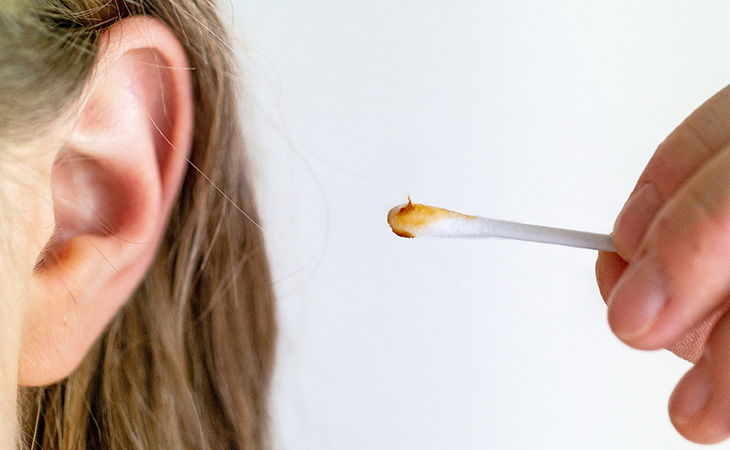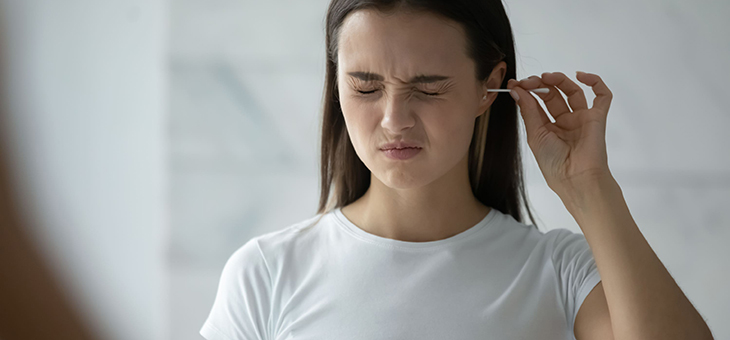It seems as if everyone has an opinion on how to clean their ears correctly.
Some people swear by Q-tipping their ears at least once a week, while others say it’s safer to let the wax build up naturally.
So, what’s the correct answer? Dr Deborah Lee reveals everything you need to know about safely cleaning your ears . . .
What is earwax and why do our bodies produce it?
You might be surprised to know that earwax contains no wax at all.
“Earwax is produced by the cells lining your outer ear and ear canal,” explains Dr Lee. “It’s made up of sebum, a natural oily substance produced in the sebaceous glands, which becomes mixed with dead skin cells, sweat and dirt.”
Essentially, our bodies produce earwax to try and protect us from infection. “The combination of sebum in your outer ear, along with hairs in the outer ear and ear canal, trap dirt and foreign particles and prevent potentially harmful bacteria and viruses from travelling down inside your ear,” she adds.
It’s quite normal for earwax to be a variety of colours – yellow, orange, brown, or black – so don’t worry if you’ve noticed a change in the shade of your wax recently, as Dr Lee assures that the colour is not important.

Is it bad to have too much earwax?
Most of us are unaware of our earwax and it rarely causes a problem, she continues. The earwax is naturally extruded from our ears, expelled by movements of our jaw, for example, when we talk or eat. Although we don’t realise it, we probably wash a little away, each time we bath or shower too.
However, Dr Lee warns that some people are more prone to developing excessive earwax. “It’s more common if you have very narrow ear canals, exceptionally hairy ears, or if you regularly use headphones,” she says, adding, “excess earwax is often troublesome in the elderly.”
Read more: Five reasons you may have muffled hearing
When too much earwax accumulates, this can pass down inside your ear canal and cause a blockage. “The lump of earwax may sit directly on top of your eardrum, or even become firmly stuck to it,” notes Dr Lee. “This then causes earache and, sometimes, sudden deafness.”

If the earwax that’s stuck deep inside your ear canal traps organisms underneath it, then Dr Lee warns that you’re at risk of developing an unpleasant ear infection.
How should we properly clean our ears?
The truth of the matter, Dr Lee says, is that you don’t need to clean your ears – they clean themselves.
“Earwax will work itself out of the ear without you doing a thing. Just accept that nature will take care of this for you,” she assures.
“The American Academy of Otolaryngology recently issued a plea to never stick anything in your ears that’s smaller than an elbow. However irritating and frustrating it is, never stick sharp objects in your ears or poke cotton buds deep inside your ear canal,” she adds.
Read more: The dangers lurking in your medicine cabinet
The reason for this is because these objects can traumatise the outer ear and introduce infection, making matters worse.
“By poking objects inside your ears, you simply jam the wax more firmly onto the eardrum, and risk a perforation, which is a serious condition,” says Dr Lee.
“A perforated eardrum increases your risk of further ear infections and will damage your hearing. It may not heal by itself and might need a surgical repair.”
If you’re worried you may have a build-up of ear wax, Dr Lee says that you should start by applying ear drops to your affected ear.
Read more: The best ways to clear out earwax
“Apply five drops twice a day for three to seven days. It can take around two weeks for you to see a benefit. However, if after this time, you still have symptoms, you should see your doctor.”
If, while you are using the drops, you develop signs of infection, such as fever, and worsening ear pain, Dr Lee says you should seek medical help.
Do you clean your ears? Do you suffer from wax build-up?
– With PA
Health disclaimer: This article contains general information about health issues and is not advice. For health advice, consult your medical practitioner.
If you enjoy our content, don’t keep it to yourself. Share our free eNews with your friends and encourage them to sign up.

